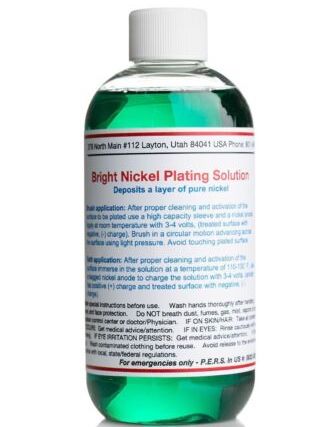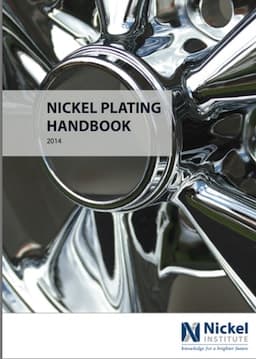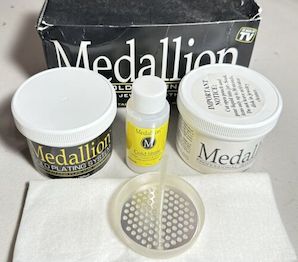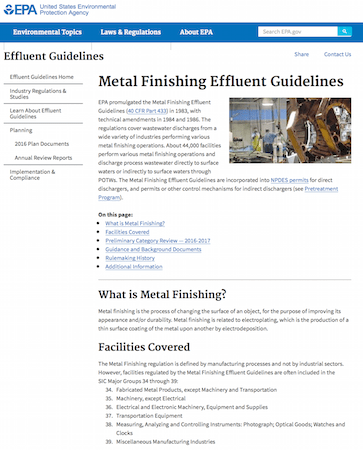
-----
Nickel Plating Solution Recipe Needed!
Q. Can anyone give me a recipe for a nickel plating solution that gives a smooth finish?
Rachel W [last name deleted for privacy by Editor]- Australia
1998
A. A Watts nickel formulation will give you a smooth matte plate:
40-8-6 ounces per gallon of nickel sulphate, nickel chloride, boric acid, respectively; pH 4.0.
It may depend on what you mean by "smooth": bright? leveled? reflective? Recipes are proprietary, and I don't know of anyone who would give this to you. You can buy or get samples from the major supply houses.

Tom Pullizzi
Falls Township, Pennsylvania
A. Hi Rachel. The formula Tom gave you gives a matte rather than bright plate, as he said; but you can buff it to brightness if you wish as they did in the old days. .
To get bright nickel plating 'as deposited' (without subsequent buffing) requires a "carrier", a "brightener", an "auxiliary brightener" and a "wetting agent". If your interest in that is primarily academic/hobbyist rather than production-oriented, then old fashioned non-proprietary nickel addition agents are well explained in the nickel plating chapter of ASM Metals Handbook, Vol. 5
⇦[this on
on Amazon
or
AbeBooks affil links].
Those older addition agents include saccharin or paratoluene as the carrier; Thiourea
⇦ on
eBay
or
Amazon [affil link] or reduced fuchsin as the brightener; sodium allyl sulfonate or 1,4-butyne diol as the auxiliary brightener; and sodium lauryl sulphate as the wetter/anti-pit agent. Good luck.
Considering the complexity of formulating addition agents though, few plating shops actually try to mix their own. They either buy the mixes from a supplier or they just plate the nickel dull/matte or semi-bright, then polish/buff it to a luster (which is what was done years ago before these addition agent systems were developed :-)
Good luck!

Ted Mooney, P.E.
Striving to live Aloha
finishing.com - Pine Beach, New Jersey
Ted is available for instant help
or longer-term assistance.
Q. There has to be an easier way to plate nickel!
Does anyone one know an easier/faster/smoother way to electroplate nickel onto copper than using a nickel sulphate plating solution?
Rachel W [returning]- Australia
![]() The person that invents a way will be in the same good position as in finding a genie in a lamp. But the lamp was probably plated with sulphate nickel (how would you release the genie if you didn't have to polish once in a while?).
The person that invents a way will be in the same good position as in finding a genie in a lamp. But the lamp was probably plated with sulphate nickel (how would you release the genie if you didn't have to polish once in a while?).

Tom Pullizzi
Falls Township, Pennsylvania
Q. Any ideas on what current density would be required for the above mentioned plating solution?
Rachel W [last name deleted for privacy by Editor]- Australia
A. About 20-30 amperes per square foot, average.

Tom Pullizzi
Falls Township, Pennsylvania
![]() Tom, you know this topic better than me, but I thought 40 ASF was the right current density for bright Watts Nickel?
Tom, you know this topic better than me, but I thought 40 ASF was the right current density for bright Watts Nickel?
Hi, Rachel,
It looks like you might be sort of winging it without a plating book or hands-on guidance. If so, please see if your library can offer one of our recommended "must-have" books.
I hope I'm not reading things wrong and offending you, but while this forum is good at answering specific questions, as Tom answered with the formula for Watt's Nickel, it's not an efficient way to introduce most people to electroplating because it's always going to bounce around whereas books are "tutorial", proceeding from scratch to deep knowledge over the course of a hundred pages, and web postings tend to either be repetitive to a maddening degree or over our heads. Plus, other readers may wrongly assume they can just jump in without safety & environmental hazards when they go unmentioned in threads like this (as evidenced by the first 7 entries)-- but they are prominently mentioned in most books. Good luck!

Ted Mooney, P.E.
Striving to live Aloha
finishing.com - Pine Beach, New Jersey
Ted is available for instant help
or longer-term assistance.
 Thanks for the vague idea of a recipe; as for "winging it" I've managed to improve that recipe and it now gives the brightest and finest finish I've ever seen in nickel plating. As for building a library - there seems little point as most books are not specific enough with respect to recipes.
Thanks for the vague idea of a recipe; as for "winging it" I've managed to improve that recipe and it now gives the brightest and finest finish I've ever seen in nickel plating. As for building a library - there seems little point as most books are not specific enough with respect to recipes.
Also you might want to reassess your ideas on who uses this site; quite a number of the threads I've read on this site seem to be written from an inexperienced point of view - and I doubt any of these "peers" would mind sharing their girth of information amongst those who find that texts are sometimes inadequate.
Rachel W [last name deleted for privacy by Editor]- Australia
I am happy that you are plating better. Sorry you don't like the service.

Tom Pullizzi
Falls Township, Pennsylvania
Dear Rachel:
We're very happy for your success, since sharing info is the very purpose of this forum! --please share your recipe for "the brightest and finest finish" .
But yes, we refer people to books for efficient tutorial learning and to increase the likelihood that they understand the hazards and appropriate safety protocols. In my own town recently a hobbyist killed himself right at his kitchen table with a cyanide copper plating solution, and put the responding police officer in the hospital ... so I don't like to jump right in to offering "recipes" without also mentioning safety and ecological disposal.
Electroplating involves haz-mat chemicals. Chromium plating solution and formaldehyde addition agents for nickel plating are known carcinogens; the cyanide required in many plating solutions is a powerful and fast-acting poison; numerous compounds when added to acid release deadly HCN and other gasses.
Then there's disposal. Hobbyists can lose their idealism when the cost to properly dispose of a small shelf of chemicals runs into 5 figures. And one large beaker of chrome plating solution smashed on the garage floor can poison all the wells for blocks around.
Best of luck in your plating work!

Ted Mooney, P.E.
Striving to live Aloha
finishing.com - Pine Beach, New Jersey
Ted is available for instant help
or longer-term assistance.
1998
opinion! Electroplating is very hazardous and I hope that morons do not try to attempt it. The person should be given full training before trying to electroplate anything.
Mack Tonhg- Sydney, N.S.W, Australia
2005
Q. Hi:
I am a retired Mech Eng. and want to gold plate, on the inside, a silver wine goblet. From what I have read on these pages it seems like I should surrender to someone who does this professionally. Seems to me I would have to clean the inside of the goblet with ?, then use an electrolyte ? in the goblet as I hook up the battery to the gold coin and the goblet. The amperage/voltage must be important. If this involves costly, hazardous chemicals I could back off but I'd like to know what would be involved.
Thank you so much,
Greg Eyolfson- Rainier, Washington
2001
A. Hello, Greg.
If you only need a thin coating, you can purchase a "liquid gold" immersion plating solution.
This requires little beyond heating the solution in a microwave and wiping the inside of the goblet with the solution . Please see our FAQ "Silver Plating at Home" for more information on immersion plating with silver or gold. Good luck!
(But, yes, dissolving your gold coin would probably involve hazardous chemicals if you go that route instead).
Good luck.

Ted Mooney, P.E.
Striving to live Aloha
finishing.com - Pine Beach, New Jersey
Ted is available for instant help
or longer-term assistance.
|
|
A. Gold Plating the inside of a Silver chalice does not require dissolving gold into any solution whatsoever. - Dallas, Texas February 8, 2009
Yes, sputtering of gold is a viable alternative to electroplating in many circumstances. More watch cases and dials are sputtered than electroplated. But I question it being a viable alternative for someone like Greg who wants one single specialty item coated. I've never heard of a shop anywhere that offers sputtering services on one-off items, and a sputtering chamber can cost several hundred thousand dollars. Yes, perhaps it's possible he could build a small informal one like you describe himself, but there's a lot of learning involved in that approach as well. Thanks again. Regards,  Ted Mooney, P.E. Striving to live Aloha finishing.com - Pine Beach, New Jersey Ted is available for instant help or longer-term assistance. |
! [Company name deleted by editor] offers training videos, complete reasonably priced kits, new processes, electroless Plating, safer chemicals. A very good site for those interested in plating on a small scale at home.
IMHO Old time platers would like us to believe that plating is some sort of "Magic." The fact of the matter is that many High Schools of Science and Technology teach basic plating practices in chemistry class. The "Old Timers" need to realize that satisfactory results can be obtained at home or in the shop with newer, safer, environmentally responsible ways.
- Springfield, Massachusetts
August 14, 2008
![]() Hi, Joseph. Nothing wrong with hobby plating kits -- go for it -- but we deleted the company name you quoted at their request; people can easily do a google search for companies marketing to hobby platers. Thanks!
Hi, Joseph. Nothing wrong with hobby plating kits -- go for it -- but we deleted the company name you quoted at their request; people can easily do a google search for companies marketing to hobby platers. Thanks!
But your claim that amateurs are up to date while professionals are out of date is ridiculous -- like saying only backyard mechanics can fix Hybrids cars, not professionals; or only midwives can do laparoscopic surgery, not surgeons; or amateur golfers know about carbon fiber club shafts but the pros don't.
- "Old time platers" visit Capitol Hill every year to meet with Congress (NASF Washington Forum) to try to get laws like the "Categorical Standards" modified, which state that every drop of water associated with plating is regulated as hazardous even if you can safely drink gallons of it.
- "Old time platers" travel the country to attend expositions/conferences (Sur/Fin 20xx, Coatings 20xx, Southern Metal Finishing) on new technologies which might ease the regulatory & environmental burden. They meet monthly (AESF Branch meetings, NAMF Chapter meetings) to insure that they hear every presentation on each new technology like trivalent chrome plating, white bronze as a replacement for nickel, zinc alloys as a replacement for cadmium, and cyanide-free silver.
- "Old time platers" sponsor research every year (AESF Research Sponsors program), paying for the university programs which study and improve plating processes.
- "Old time platers" write the peer-reviewed journal articles (Plating & Surface Finishing, Metal Finishing, Journal of Applied Surface Finishing) which keep us up to date with the latest developments.
- "Old time platers" have training & certification programs which test whether they actually know their stuff (Certified Electro-Finisher, Master Surface Finisher) vs. who is just talking out of their axx.
- "Old time platers" sponsor those high school science fairs you talked about (the Milwaukee Science Fair and Chicago Science Fair), as well as contests for aspiring auto designers (The Bright Design Challenge), etc.
Meanwhile people selling plating out of their garage are in violation of countless laws including failure to have a NPDES permit, failure to follow DOT registration requirements in transporting their waste to the dump, failure to register the start date for their hazardous waste accumulation, failure to test that everything going to the drain is within the required ppm range, failure to register for the MACT program, and failure to alert their neighbors of the chemicals they have on hand ("Community Right to Know Act"). If a neighborhood child develops cancer of any type for any reason, and her parents find out you were chrome plating in your garage, God help you.
Everyone is in favor of "newer, safer, environmentally responsible ways"; but talk is cheap and it is "old time platers" who prove their environmental responsibility by maintaining all of the required permits, which in turn means they are regularly inspected by the regulatory authorities, while the garage platers don't register, remain ignorant of the law, hide below the radar, and guess that they are not doing too much environmental damage, although they often lack the knowledge to actually know. The worst case of plating pollution that I am aware of in a 45-year career was from a chrome shop in a 2-car garage (Odessa Chrome Superfund Site / U.S. vs. Sequa et al). It will be so costly that the legal fees (before the actual clean up costs even begin) is in the multi-millions.
Your turn.
Regards,

Ted Mooney, P.E.
Striving to live Aloha
finishing.com - Pine Beach, New Jersey
Ted is available for instant help
or longer-term assistance.
 Oh my God, I can't believe what I'm reading on this page. The OP just wanted to plate something, for crying out loud! And the mods on the forum reply with, "Sure, this is finishing.com, where we expertish persons teach the layperson how to do things, and we know you want to plate something in nickel, so tell you what. We'll tell you how to do it: go read a book on the subject. Lots and lots of books on the subject. And don't forget to refer a friend to the experts on finishing.com!"
Oh my God, I can't believe what I'm reading on this page. The OP just wanted to plate something, for crying out loud! And the mods on the forum reply with, "Sure, this is finishing.com, where we expertish persons teach the layperson how to do things, and we know you want to plate something in nickel, so tell you what. We'll tell you how to do it: go read a book on the subject. Lots and lots of books on the subject. And don't forget to refer a friend to the experts on finishing.com!"
Then you guys go on a windy diatribe about the hazards of plating something, which follows this line: "Plating is serious business. You're dealing with corrosive chemicals known to the State of California to give the children in your neighborhood terminal cancer if they breath the stuff just once. You think handling radioactive waste is hazardous? The chemicals used in nickel plating makes radioactivity look like a mosquito bite! I mean, you're dealing with deadly chlorine gas, where one drop can burn straight through your steel-toed boot. And sodium chloride, which releases a lethal, deadly stinking gas cloud upon exposure to citric acid that will blanket several square miles, causing death all around. PLATING IS NOT FOR MORONS! You must come prepared wearing a radioactive suit, a 100 psi halon fire extinguishing system, and fume-hood conduit throughout the working area. And this is if you just want to plate a doorknob or something..."
- san diego California, USA.
September 5, 2011
![]() Hi, Glenn.
Hi, Glenn.
The original poster was immediately given the formula she asked for if she wanted to make her own nickel plating solution rather than buy a bottle. Each reader will decide for themself whether you or we who are more guilty of exaggeration :-)
Regards,

Ted Mooney, P.E.
Striving to live Aloha
finishing.com - Pine Beach, New Jersey
Ted is available for instant help
or longer-term assistance.
![]() It's pretty funny to see a complaint about safety concerns. Plating uses a ton of chemistry, and if you've had formal education on it, you know that certain chemicals can harm you. But, what you don't know is just how badly or quickly unfamiliar chemical solutions can hurt you and others.
It's pretty funny to see a complaint about safety concerns. Plating uses a ton of chemistry, and if you've had formal education on it, you know that certain chemicals can harm you. But, what you don't know is just how badly or quickly unfamiliar chemical solutions can hurt you and others.
So good, you want to plate a doorknob? Well, I hope everyone gives the warnings before someone goes and harms themselves, their family, and their community!
Great advice is on this site, and the warnings are part of what's so great about it.
- Honolulu, Hawaii, USA
November 6, 2011
Q. I came across this thread looking for info on preparing a nickel electrolyte solution for plating coldroll steel.
I agree with some other posters above in regards to how the op's question really never got answered- So here's my question...
I'm a microbiologist (with a little knowledge in organic chemistry)- so I'm not a noob on handling chems, but I am a bit ignorant on the plating process (despite the countless hours of reading about it on-line.)
I have basically access to all the chemicals I need. I built a plating tank- and even a makeshift BSC to carry the fumes up & out of my garage.
I'm using an 8" x 1/4" 99.9% pure nickel filler rod for my anode. As for the solution, like the op asks, I'd like some direction. I'm plating a few 16" x 2" steel cannon barrels.
As for chems- I have nickel sulphate, glacial acetic acid
⇦ on
eBay
or
Amazon [affil link] , hydrochloric acid, nitric acid & sulfuric acid.
I see a lot of conflicting info on-line about how to properly prepare the steel to be plated- and an equally amount of ways to prepare a basic nickel electrolyte.
yes- I know there is no such thing as a "basic" solution just like there is no "basic" cookie recipe- but there are elements that every nickel plating solution has- and I was wondering what those are?
for example- 3 tablespoons of nickel sulphate, 1 oz boric acid, 1 qt distilled water.
- worcester, mass USA
December 25, 2011
A. Hi, Michael. Tom immediately answered the OP's question in the first response, but to re-iterate --
The most common nickel plating solution is Watts' Nickel. It consists of:
- 225 to 300 g/l NiSO4.6H2O (nickel sulphate hexahydrate)
- 37 to 53 g/l NiCl2.6H2O (nickel chloride hexahydrate)
- 30 to 45 g/l H3BO3 (boric acid).
It is operated at 140 °F, pH 4.0, and current density of up to 40 ASF.
Sorry that we tend to use metric units like grams per liter rather than ounces/teaspoons per quart.
Without brightening agents, this will not be bright as plated; you'll have to buff it for brightness.
The very easiest way to clean onesy-twosy items is to scrub them with a solution of pumice ⇦ on eBay or Amazon [affil link] , a little detergent, and warm water, using an old-fashioned tampico scrub brush ⇦ on eBay or Amazon [affil link] . Then rinse, a quick 30-sec dip into say 20% HCl, rinse, and into the plating tank. Best of luck!
Regards,

Ted Mooney, P.E.
Striving to live Aloha
finishing.com - Pine Beach, New Jersey
Ted is available for instant help
or longer-term assistance.
![]() Several years ago I started plating as part of a small artisan workshop. I restrict myself to the less hazardous salts and find other alternative non-plating routes where necessary. I have a growing library of plating books and downloaded academic papers. I am not a chemist by education (physicist).
Several years ago I started plating as part of a small artisan workshop. I restrict myself to the less hazardous salts and find other alternative non-plating routes where necessary. I have a growing library of plating books and downloaded academic papers. I am not a chemist by education (physicist).
My operation is small (25 litres is a lot of electrolyte in my workshop) bunded containers of course, 1st wash pull out is recycled back into the electrolyte to replace evaporation losses (almost zero loss to the environment) and I am prepared to pay for disposal (my political allegiance is Green).
I understand the frustrations of amateurs wanting to do an adhoc job but as I progress and improve more I fully understand their concerns. The idea of folks flushing nickel or worse down drains, getting exposed to things they should not and so on is scary and its not always the person doing the plating who will pay the price.
I have invested time and money into making sure that my set up is environmentally sound, even though I am the only worker I still have documented work flows and practices not only to keep me on the straight and narrow but to avoid impact on my finished articles - I have a motivation in the sense that it is a small artisan business ( not a plate shop )and I have every reason to continue to refine, improve and learn and also the local authorities have the right to come round and check me out - I am just not sure a weekender has the same motivation.
Sorry to sound like I am sucking up to the pros and of course if they inspected my set up they still might find fault despite all my labours and research. That's precisely why I agree with them and wish to continue to learn from them not for a day or two but year in and year out.
Ted - keep on your current course you are right IMHO, you try to tread the difficult path between encouraging kids with school projects yet pointing out the environmental and safety pit falls. Unfortunately we live in an age of knee jerk reactions and people who have had no training or relevant education who think they know better than the experts. Despite photographs of the surface of Mars or the cure of many types of cancer and miracle eye operations the average Joe still thinks he knows better than the "experts" who achieved those things -- in his/her view Doctors are still talking out of their bottoms and news of man's impact on the environment is nothing more than chinese whispers. I am fed up with it and long for the times when people listened to those who know rather than those who shout loudest or get on their indignant soap box and share their "facts" with others. Experts are wrong sometimes but at least they were not guessing - anyone can toss a coin and be right some of time but science and civilisation has rejected guessing in favour of knowledge and it works most of the time.
- Saltum Jylland Denmark
November 25, 2016
Thanks for the kind thoughts, Jon, and best wishes with your continuing efforts.
An advantage that hobbyists have over production platers that may help them focus on the important stuff, and not get lost in the woods worrying about things they don't need to worry about, is that hobbyists don't need 'equilibrium processes' like production platers do.
If your tank heats up or cools down just a little over the course of plating a part, or the pH rises or falls a little, or the nickel concentration drops a little, or the cleaning tank gets a little dirtier, or the acid a little weaker, or your anodes are not nickel S-rounds so they don't corrode at precisely the perfect rate, it's no problem as long as the part plated properly :-)
But if a production plater's first batch of parts goes into the tank at 7 AM, and the next batch at 7:10, and another one every 10 minutes for the rest of the day, 'little changes' are cumulative and the whole process will soon stop working. In turn, that means that the condition of the solution must be exactly the same when a part is finished plating as when it began -- and some nickel plating tanks operate that way every day for 20 years without being dumped and re-made. People who are only plating an occasional part don't to worry themselves about maintaining perfect equilibrium like that :-)
Regards,

Ted Mooney, P.E.
Striving to live Aloha
finishing.com - Pine Beach, New Jersey
Ted is available for instant help
or longer-term assistance.
Q. I'm a newbie to this and while I have a physics degree and understand the basics, it appears to be mostly trial and error insofar as proprietary solutions are concerned.
I'm looking to do some copper electroforming on a small commercial scale, along with subsequent nickel, silver and then some gold plating over the copper. What do I have to do to be legal? The copper sulphate
⇦ on
eBay or
Amazon [affil link] is sprayed by the state on the roadsides here to prevent roots from growing. The nickel I'm doing is nickel acetate and I don't plan on throwing any away if I can help it. The silver is a silver nitrate-sodium thiosulphate
⇦ on
eBay
or
Amazon [affil link]
-potassium metabisulfite. THERE'S NO CYANIDE HERE.
Ted Mooney mentions an NPDES permit, I went on their website and it clearly says if you dispose into a municipal waste water system you don't need it. He also mentions a DOT permit, I looked and my state is unregulated for that.
What is all of this talk of unregistered platers? Or is this only referring to cyanide and chromium types?
More information would be much appreciated.
- kamuela, Hawaii, usa
October 4, 2016
A. Hi Ryan. An issue that may not have yet made clear to you by us or by the regulatory agency is that waste regulations are based not just on what a waste is, but also where it came from. Even before there was an EPA, plating shop wastes were regulated by the Department of the Interior, which selected electroplating as the very first industry to be subjected to 'categorical standards' (that is, effluent limitations based not just on the hazards, but based on the industry which generated them). Thus, copper sulphate might well be no issue for a home owner with a koi pond, or even for other industries, yet still be tightly regulated for electroplating use.
Plating shops who discharge to a sewer -- municipal waste water system, POTW (publicly owned treatment works) --absolutely, positively, without question or exception must comply with EPA/NPDES discharge standards! The way it actually works, though, is that the EPA delegates the responsibilities to your local POTW (sewer system): you apply for a discharge permit from your local POTW (sewer system) and they give you the standards you must adhere to (which can be tighter but cannot be laxer than federal standards), and the POTW is required to monitor you, while the EPA monitors them and that they are monitoring you.
But a small custom jewelry designer might not be considered a 'plating shop' (you & I can't make that ruling; the EPA does). If you are discharging to a municipal waste water system, they are charged with enforcing whatever are the applicable standards for your operation, so that's who to contact. Although I suspect that most small custom jewelry designers don't register, I think you might be considered a plating/metal finishing shop, but hopefully not. Good luck.
Regards,

Ted Mooney, P.E. RET
Striving to live Aloha
finishing.com - Pine Beach, New Jersey
Ted is available for instant help
or longer-term assistance.
Q. OK so y'all scared me!! I usually like to at least try to do things once but this seems a little over my head. So can anyone nickel plate an old kerosene lamp for me? Or at least point me in the right direction. Thanks.
Dave Fedderke- Defiance Ohio USA.
January 13, 2018
Ed. note: This RFQ is outdated, but technical replies are welcome, and readers are encouraged to post their own RFQs. But no public commercial suggestions please ( huh? why?).
 This thread is very unhelpful. The question was about a recipe for bright nickel plating. The answers were about books, hazards, regulations, etc., etc, but not about the recipe. Doesn't matter if you are professional or not -- if you have nothing to say on the subject, don't post. Don't waste other peoples' time and yours.
This thread is very unhelpful. The question was about a recipe for bright nickel plating. The answers were about books, hazards, regulations, etc., etc, but not about the recipe. Doesn't matter if you are professional or not -- if you have nothing to say on the subject, don't post. Don't waste other peoples' time and yours.
Research - Los Angeles, California, USA
May 27, 2018
![]() Hi Anatoly. The requested recipe was given in the first response to the first posting, to wit:
Hi Anatoly. The requested recipe was given in the first response to the first posting, to wit:
40-8-6 ounces per gallon of nickel sulphate, nickel chloride, boric acid, respectively; pH 4.0."
Readers remain free to stop there if they are only interested in the recipe and have no interest in books, training, hazards, & regulations; or to continue on according to their interests. Some readers will surely appreciate your posting, others will probably feel that you had nothing to say and shouldn't have wasted other people's time and yours :-)
Daht in dah da da' dah, daht in da' da dah."
-- Ricky Nelson, "Garden Party".
Regards,

Ted Mooney, P.E. RET
Striving to live Aloha
finishing.com - Pine Beach, New Jersey
Ted is available for instant help
or longer-term assistance.
May 2018
![]() I'm a just a novice at plating and I make metal jewelry. Thank goodness my jewelry is better than my plating. I only use plating to cover up soldering.
I'm a just a novice at plating and I make metal jewelry. Thank goodness my jewelry is better than my plating. I only use plating to cover up soldering.
I come here for help and roughly 99% of the time I get just that. I am astonished that people come here, get the "FREE" help they need, then bitch about getting too much, particularly when they're bitching about someone else's question. For those folks, go to Google, if they're not completely satisfied, complain to Google.
- Wichita, Kansas
May 18, 2020
Addition agents for D-I-Y bright nickel plating
Q. I tried Watt's nickel a couple years ago - it worked great.
BUT I would love to find practical additions to get a bright result without buffing. Using only HARMLESS chemicals like the above-mentioned saccharin.
BTW: safety data for most chemicals are found on line. Wikipedia is a good start.
- portland Oregon USA
October 28, 2018
A. Hi Jim. You can try sodium saccharin and formaldehyde, which should be readily available and semi-bright to bright. Maybe a g/l or two of saccharin and 1/10 as much formaldehyde.
I know that people don't want to hear that the best nickel brighteners/addition agents are proprietary, but unfortunately they are "synthesized from precursors" -- in other words hobbyists can't make such chemicals because they're not "mixes", they're produced by high temperature, high pressure, synthesis (like making plastic from oil), and it is simply beyond the capability of even avid individuals to build & operate an organic chemical manufacturing plant. That is the milieu of Dow and Dupont, not hobbyists. Just as you can't "make" Teflon yourself, you can't make the 'perfect' nickel brightener yourself ... but you can certainly make some passable generic ones.
If you try the saccharin and formaldehyde, please let us know what you learn :-)
Regards,

Ted Mooney, P.E. RET
Striving to live Aloha
finishing.com - Pine Beach, New Jersey
Ted is available for instant help
or longer-term assistance.
A. I'm no expert on any of this but I'm a retired engineer who enjoys restoring cars. I needed to introduce some basic nickel plating to some of the refurbished parts. Here's what I've learned so far. If you're only only plating a few items either buy a pre-mixed plating solution or make your own out of basic off shelf supermarket ingredients. Distilled white vinegar ⇦in bulk on eBay or Amazon [affil link] and salt.
Put a liter of vinegar in a container and mix in a couple of teaspoons of salt. Using a power supply of about 5 Volts attach the leads to two titanium wire lengths which carry the nickel pieces into the solution. Using titanium will keep the solution uncontaminated. Don't put cables or clips into the solution especially keep copper away. The cathode (negative) will produce bubbles and the solution will slowly change to pale green after about two hours. the solution will draw about 500 mA current. Use a fresh dry bottle to store the solution. Any metal to be plated must be rust-free and grease-free. The better the finish, the better the plating. It's common sense, light aggregate cleaning first, then smoothing, and finally wash off in distilled water, hot air dry and final clean with acetone.
Wear gloves so as to avoid transferring human skin oils when handling. Wire up components on titanium wire and suspend in tank of solution connected to negative terminal. On positive terminal do same with nickel anode. Switch on and components will start to bubble as the nickel is plating. Once you're satisfied that the nickel has covered the items (it can take up to two hours), remove and wash off in water. Don't over-polish them. Use a hard felt wheel with white bar metal polish (I think it's the same one for stainless) -- polish lightly. If you've prepared everything with care you should get a nice finish between matte and bright and you won't have endangered yourself with any chemicals. Obviously wash your hands frequently.
Hope this helps anyone new to the process. The salt by the way simply makes the solution more conductive, use a test meter to check the current drawn.
Joe Doherty- midlands UK
October 30, 2019
Q. Hello, I have some brass musical instruments whose nickel or monel valves need replating. My intention was to put a very thin copper plate on them at first and then nickel plate them afterwards as that what I was told is a must. I'll show you what a valve looks like with a photo. The part being replated is indicated as "Oil and clean this part". It is about 0.6 in diameter. Plating inside those holes is not critical. I need about 0.001 in, of plate on. Since this is round, that would add about 0.002 on to the diameter. I intend to lap the part afterwards while mating it back into it's bore. What's of the utmost importance is that this plate never flakes.
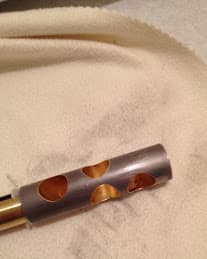
I'm a graduate Electronics tech, Machinist and 2 years of University chemistry. Having said that, I have no experience with electroplating. I do have variable power supplies and a magnetic heater stirrer.
I look forward to hearing from you on this adventure.
Hobbyist - Toronto, Canada
August 29, 2021
A. Hi Joe. Your question was addressed to Joe Doherty and we will try to advise him of it, but his posting was from 2 years ago. You are certainly welcome to try plating the valves yourself but I would suggest that you practice on some scrap material first especially in view of your statement that "What's of the utmost importance is that this plate never flakes."
That is a very tall order when plating onto old nickel or monel. I would not attempt to copper plate them if I were you but would search the site for "Wood's Nickel Strike" to better understand the issue and possible solutions. Good luck!
Regards,

Ted Mooney, P.E. RET
Striving to live Aloha
finishing.com - Pine Beach, New Jersey
Ted is available for instant help
or longer-term assistance.
Q. Thanks Mr. Mooney. I'm not sure what article you refer to because this site includes a vast Google Search on their tool. What I did find on this site about Wood's Nickel directs the reader to go to the Metal Finishing Guidebook, only to be told it's no longer available. Can I risk trespassing on your generosity in asking for a direct link to the article you intended ? A digital link to that book would be even better if anyone has it. Since they are no longer selling it, we would not be depriving the Publisher of revenue from a sale.
I do not know what you meant by "natural passivity" in that link but perhaps you meant high resistance ? I do not know how to calculate ASF. I also don't know who would sell me the raw materials for Woods. Thank you for your time.
- Toronto, Canada
A. Hi again, Joe. You are right that there are many threads on this site about even such narrow subjects as the Wood's Nickel Strike -- which brings us back to you being welcome to experiment with plating but others being unable to distill the art & science down to a paragraph or two.
The page you mentioned will serve as well as any other single page to introduce you to Wood's; and it doesn't say the Metal Finishing Guidebook is unavailable; rather, it links to an on-line copy. Download it quick because access could disappear at any time, as previous digital copies have come & gone epeatedly over the years :-)
One thing to realize about electroplating is that for it to be truly useful rather than being just a cheap paint job, it almost always needs to be corrosion resistant and to exhibit excellent adhesion to the substrate that it is plated onto. Getting plating to occur is one thing; getting it to stick right is another. Old nickel surfaces are quite conductive so getting plating to occur on them is relatively easy. But those nickel surfaces have a "natural passivity": an oxide film quickly forms on them; and for proper adhesion, plating must be applied to raw metal not to an oxide film. The way to solve that issue is with an initial layer applied from a solution which is both a very strong acid as well as a plating solution -- a "Nickel Strike", the best known of which is Wood's. After the Wood's, you can proceed quickly to a conventional nickel plating solution like Watts for the bulk of the plating.
ASF means amps/square foot. You would need to estimate the surface area of your valve and multiply by the suggested ASF for the process, maybe 20-40 ASF for nickel striking and plating. Chemicals may be obtainable from hobby plating suppliers or commodity chemical suppliers. Unfortunately the large vendors of plating processes may be unwilling to sell to a hobbyist or ship to a residential address for product stewardship & liability reasons :-(
Luck & Regards,

Ted Mooney, P.E. RET
Striving to live Aloha
finishing.com - Pine Beach, New Jersey
Ted is available for instant help
or longer-term assistance.
https://www.finishing.com/books/MFG.shtml says:
I'll get on this per your directions. I was hoping to avoid adhesion problems by vigorous cleaning and reverse electrodes for a few minutes and immediately going to plating. I didn't realize that would not be sufficient. I am of course finding solutions (the liquid stuff) online all over the place and was wondering if anyone had had any luck with that? At the same time, I am cognizant of Steinbeck's great quote
"People don't want advice, they want corroboration."
Rather I'm trying to take an easier route to acquiring chemicals. That could be my undoing :-)
- Toronto, Canada
August 31, 2021
A. Hi. A digital copy of the Guidebook is currently available at:
Apologies, and thanks for finding that page which had not been updated with this info; it now has been.
On-line access to the Metal Finishing Guidebook has been on-again off-again for years, and maintaining working links and current info on 50,000 pages going back to 1989 has been quite a challenge ... so we appreciate when people tell us about broken links or dated information they discover here :-)
Luck & Regards,

Ted Mooney, P.E. RET
Striving to live Aloha
finishing.com - Pine Beach, New Jersey
Ted is available for instant help
or longer-term assistance.
Q. Well, I decided to go ahead with this folksy DIY Instructable that calls for vinegar and Peroxide to make a copper bath ergo copper plate first as I have been repeatedly warned about trying to get nickel to stick to monel or old nickel plate. I was going to use the 10 ASF for the copper but with my surface area around 0.034 Sqft and me dialing in 340 mA, my voltage dropped to zero. I have to crank it up to satisfy Ohm's Law but I am sitting kind of low still at 3.9 vdc and 460 mA. Interesting that the part closest to my stirring bead got short changed on plate, so I have moved things around a bit to keep the solution current from flowing too strongly against any particular area. what you see is about 1 hr of plating. ...
Joe Ganczarz [returning]- Toronto, Canada
Q. Doing the newbie safe version of Ni plating. I first put a thin Cu plate on my old monel trumpet valves and followed it with a nickel plate. In both solutions, vinegar was used. Peroxide was used in the copper bath but only vinegar and salt for the Nickel bath. I am using old Canadian Nickels which were something like 99.9 % pure for certain year ranges that I chose. Since I am suspending them with a copper wire through drilled holes, there may be some Cu leaching, however, I tried some Ni strips also without need for wires and they too produced this ash-like residue in the solution. I also notice a soot-like black residue on the plating itself, I need to scrub off. Can someone suggest why this is happening and is this the reason I see for many recommending a filter bag around the anode?
Joe Ganczarz- Toronto Ontario
A. I am a knowledgeable finisher and also a hobby trumpet player. I am not an instrument restorer. I don't think adding electroplating to a monel instrument valve is likely to result in an acceptable tolerance fit that would allow the valve to perform satisfactorily unless the valve housing is much too large for the valves. I have an antique trumpet (110 years old) that does have a sloppy fit between the valves and the valve housing, but I believe that electroplating the valve would not be the way to restore that. Instead the housing would need to be re-bored and then the valves would be remade completely (not plated) to fit the housing. I don't have any first-hand knowledge in instrument restoration, so this is just my opinion of how I think that it is done.

Jon Barrows, MSF, EHSSC
Kansas City
A. Hi. Countless things from shafts to molds, to lithographic rolls, to pistons & valves are routinely electroplated to restore or increase dimension (although they are not often made of monel).
But when something once round now fits too loosely into a once round hole, it can be a leap of faith to believe that both have worn evenly and are still round. And to expect the plating to be of uniform thickness takes a second leap of faith. :-)
I know nothing of musical instrument repair, but in other fields it would not be unusual to hone the bore to roundness, plate the piston oversize, then grind it down to a proper fit in the new hole size. Sorry but I have no idea if that is workable for trumpet valves :-(
Luck & Regards,

Ted Mooney, P.E. RET
Striving to live Aloha
finishing.com - Pine Beach, New Jersey
Ted is available for instant help
or longer-term assistance.
